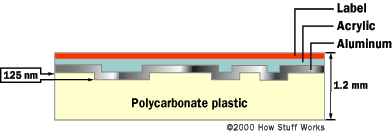How do CD's work?
CDs are made of plastic. Each CD has a microscopic spiral line that starts at the CD center, and continues on outwards. This is loaded with binary code, which is composed of clusters of eight 1's and 0's, called bytes.
This track of data contains bumps or pits, which represent 0, thus making the absence of a bump a 1. The laser is sent to the surface of the disc and reflected into a receptor if no bump is present, activating said receptor, and making a 1. if the laser encounters a bump, the light does not reflect into the receptor and the CD Reader marks a 0.
A CD can fit more than 783 megabytes onto a disc only 12 cm in diameter. This requires that the individual bytes be very small. By examining the physical construction of a CD, we can begin to understand how small these bytes are:
Sound
The binary code creates samples of sound occurring approximately 40,000 times per second. This is known as the sampling frequency and is measured in units of hertz.
A CD can store up to 74 minutes of music, so the total amount of digital data that must be stored on a CD is:
44,100 samples/channel/second x 2 bytes/sample x 2 channels x 74 minutes x 60 seconds/minute = 783,216,000 bytes
A CD delivers a square (digital) signal that closely resembles the form of its analog counterpart:


